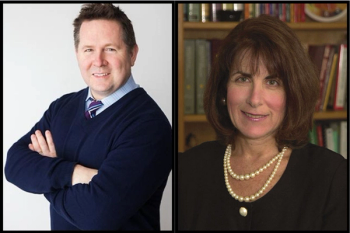
Oncology NEWS International
- Oncology NEWS International Vol 9 No 2
- Volume 9
- Issue 2
Rituximab Retreatment of NHL Produces Long Responses
ROCKVILLE, Md-The monoclonal antibody rituximab (Rituxan), which is directed against the CD20 antigen expressed in most B-cell malignancies, can be given repeatedly to patients with non-Hodgkin’s lymphoma (NHL) and may produce longer responses with retreatment. This unusual increase in response duration is in contrast to the ever-diminishing efficacy seen with repeated rounds of chemotherapy, researchers reported at the 41st annual meeting of the American Society of Hematology (ASH).
ROCKVILLE, MdThe monoclonal antibody rituximab (Rituxan), which is directed against the CD20 antigen expressed in most B-cell malignancies, can be given repeatedly to patients with non-Hodgkins lymphoma (NHL) and may produce longer responses with retreatment. This unusual increase in response duration is in contrast to the ever-diminishing efficacy seen with repeated rounds of chemotherapy, researchers reported at the 41st annual meeting of the American Society of Hematology (ASH).
The increase may indicate that some novel antitumor immune response is acting in addition to classic antibody-dependent, cell-mediated cytotoxicity in patients who respond to rituximab.
Thomas A. Davis, MD, and associates from the National Cancer Institutes Investigational Drug Branch reported final data showing the following results: Patients with NHL can be repeatedly treated with rituximab. The overall response to retreatment (40%) is about the same as the response to initial rituximab. The median response duration following rituximab retreatment is longer than that following initial treatment.
This study shows that patients can be treated safely and effectively with multiple courses of rituximab without induction of human antichimeric antibody (HACA) and without the myelosuppres-sion common after multiple courses of chemotherapy, Dr. Davis said.
Ronald Levy, MD, commented that the data show that rituximab is a rare example of a cancer treatment that produces second-course results at least as good as, and sometimes better than, the initial cycle. I dont know of any other cancer treatment for which that is true, he said at a symposium sponsored by Genentech BioOncology and IDEC Pharmaceuticals. Dr. Levy is chief of the Division of Oncology, Stanford University.
Dr. Daviss study was an open-label, single-arm, phase II trial conducted among 60 patients (33 males and 27 females). Patients median age was 56 years (range, 31 to 81 years). Most (46/60) had stage III or stage IV disease at the time of diagnosis. Median time since diagnosis was 4.7 years (range, 0.2 to 17 years). All patients were CD20-positive at baseline.
Inclusion criteria included response to previous rituximab therapy, low-grade or follicular NHL, and measurable, relapsed disease requiring further treatment. Nearly all patients (58/60) had prior chemotherapy, with a median of two courses, and 30% had prior radiotherapy. All patients had prior rituximab, with a median of 15.9 months between current and prior rituximab therapy. Patients were treated with four weekly infusions of rituximab at 375 mg/m².
Impressive Responses
The overall response rate was 40%, comparable to that seen in studies with patients naïve to rituximab therapy, Dr. Davis reported (see Table 1). Median time to progression and duration of response had not yet been reached at the time of the ASH meeting report. Kaplan-Meier estimated medians were 16.7+ months for time to progression and 15.0+ months for duration of response. These times were longer than the medians achieved during the patients prior courses of rituximab (see Table 2).
The magnitude of responses was impressive. In the 6 patients with a complete response, mean lesion reduction was 98%. In the 17 patients with a partial response, mean lesion reduction was 86%. In the 31 patients with stable disease, mean lesion reduction was 32%. Even more intriguing, Dr. Davis said, the median sum of the products of the perpendicular diameters continued to decline through 16 months post-treatment.
Rituximab was well tolerated on retreatment. Dr. Davis said that 98% of adverse events were transient and grade 1 or 2. Most (56%) were associated with the first-infusion syndrome, and the incidence fell after the first infusion. There was no significant myelosuppression.
The long duration of responses in retreated patients inspired considerable discussion. Dr. Levy noted that the effect lasts long after rituximab has disappeared from the circulation (140 days). With other monoclonal antibodies, B cells tend to reappear soon after the antibody has been eliminated from the circulation.
Dr. Levy proposed that this difference may be due to a novel mechanism: a rituximab-mediated immunization against B cells, resulting in induction of a wave of cytotoxic T cells against B cell antigens, which may amplify antigen-mediated cellular cytotoxicity against B cells. Nothing we have known about monoclonal antibodies in the past would have predicted the result [that B cells would not recur for more than 1 year], he said.
Articles in this issue
almost 26 years ago
Neoadjuvant Docetaxel Increases Response Rate in Large Breast Tumorsalmost 26 years ago
Faslodex, a Pure Antiestrogen, Shows Antitumor Activityalmost 26 years ago
Consider Node Dissection, Adjuvant Therapy in Elderly Breast Cancer Patientsalmost 26 years ago
Tumor-Associated Proteases Predict Outcome in Node-Negative Patientsalmost 26 years ago
Herceptin Plus Vinorelbine a Promising Combination in Advanced Breast Canceralmost 26 years ago
Small Risk of Breast Cancer Death After Invasive Recurrence in DCIS Patientsalmost 26 years ago
Paclitaxel/Herceptin Effective in Metastatic Breast Canceralmost 26 years ago
Conservative Surgery Alone Not Sufficient to Prevent RecurrenceNewsletter
Stay up to date on recent advances in the multidisciplinary approach to cancer.































































































